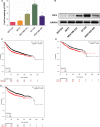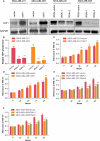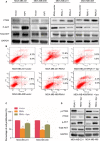YAP1 overexpression is associated with poor prognosis of breast cancer patients and induces breast cancer cell growth by inhibiting PTEN
- PMID: 30868052
- PMCID: PMC6396162
- DOI: 10.1002/2211-5463.12597
YAP1 overexpression is associated with poor prognosis of breast cancer patients and induces breast cancer cell growth by inhibiting PTEN
Abstract
YES-associated protein 1 (YAP1) plays a key role as a transcriptional coactivator in the Hippo tumor suppressor pathway. YAP1 is overexpressed in a variety of cancers and is considered to be encoded by a proto-oncogene. However, the role of YAP1 remains debatable, because both gain and loss of YAP1 expression have both been reported in breast cancer (BC). Here, we found that elevated expression of YAP1 mRNA in BC was negatively correlated with relapse-free, distant metastases-free and overall survival rates. We then knocked down or overexpressed YAP1 in human BC cells, and examined cell proliferation, apoptosis, and tumorigenic ability in vivo. We identified that YAP1 promotes cell growth and inhibits cell apoptosis of BC through the phosphatase and tensin homolog deleted on chromosome 10-AKT signaling pathway, and thus suggest that YAP1 might serve as a new target for inhibiting BC progression.
Keywords: AKT; Hippo; PTEN; YAP1; apoptosis; breast cancer.
Conflict of interest statement
The authors declare no conflict of interest.
Figures




Similar articles
-
LncRNA NNT-AS1 promotes non-small cell lung cancer progression through regulating miR-22-3p/YAP1 axis.Thorac Cancer. 2020 Mar;11(3):549-560. doi: 10.1111/1759-7714.13280. Epub 2020 Jan 10. Thorac Cancer. 2020. PMID: 31923353 Free PMC article.
-
Long non-coding RNA PICSAR knockdown inhibits the progression of cutaneous squamous cell carcinoma by regulating miR-125b/YAP1 axis.Life Sci. 2021 Jun 1;274:118303. doi: 10.1016/j.lfs.2020.118303. Epub 2020 Aug 22. Life Sci. 2021. PMID: 32841663
-
The LXR-623-induced long non-coding RNA LINC01125 suppresses the proliferation of breast cancer cells via PTEN/AKT/p53 signaling pathway.Cell Death Dis. 2019 Mar 13;10(3):248. doi: 10.1038/s41419-019-1440-5. Cell Death Dis. 2019. PMID: 30867411 Free PMC article.
-
PTEN and Other PtdIns(3,4,5)P3 Lipid Phosphatases in Breast Cancer.Int J Mol Sci. 2020 Dec 2;21(23):9189. doi: 10.3390/ijms21239189. Int J Mol Sci. 2020. PMID: 33276499 Free PMC article. Review.
-
Increased YAP1 expression is significantly associated with breast cancer progression, metastasis and poor survival.Future Oncol. 2021 Jul;17(21):2725-2734. doi: 10.2217/fon-2020-1080. Epub 2021 Apr 21. Future Oncol. 2021. PMID: 33880946
Cited by
-
Cisplatin and phenanthriplatin modulate long-noncoding RNA expression in A549 and IMR90 cells revealing regulation of microRNAs, Wnt/β-catenin and TGF-β signaling.Sci Rep. 2021 May 17;11(1):10408. doi: 10.1038/s41598-021-89911-z. Sci Rep. 2021. PMID: 34001990 Free PMC article.
-
YAP1 is an independent prognostic marker in pancreatic cancer and associated with extracellular matrix remodeling.J Transl Med. 2020 Feb 13;18(1):77. doi: 10.1186/s12967-020-02254-7. J Transl Med. 2020. PMID: 32054505 Free PMC article.
-
Effects of Quinacrine on Expression of Hippo signaling Pathway Components (LATS1, LATS2, and YAP) in Human Breast Cancer Stem Cells.Asian Pac J Cancer Prev. 2020 Nov 1;21(11):3171-3176. doi: 10.31557/APJCP.2020.21.11.3171. Asian Pac J Cancer Prev. 2020. PMID: 33247672 Free PMC article.
-
Yes-associated protein-1 overexpression in ocular surface squamous neoplasia; a potential diagnostic marker and therapeutic target.Front Oncol. 2023 Jul 5;13:1213426. doi: 10.3389/fonc.2023.1213426. eCollection 2023. Front Oncol. 2023. PMID: 37476371 Free PMC article.
-
Transcription factor glucocorticoid modulatory element-binding protein 1 promotes hepatocellular carcinoma progression by activating Yes-associate protein 1.World J Gastrointest Oncol. 2023 Jun 15;15(6):988-1004. doi: 10.4251/wjgo.v15.i6.988. World J Gastrointest Oncol. 2023. PMID: 37389116 Free PMC article.
References
-
- Siegel R, Ma J, Zou Z and Jemal A (2014) Cancer statistics, 2014. CA Cancer J Clin 64, 9–29. - PubMed
-
- Ferlay J, Steliarova‐Foucher E, Lortet‐Tieulent J, Rosso S, Coebergh JW, Comber H, Forman D and Bray F (2013) Cancer incidence and mortality patterns in Europe: estimates for 40 countries in 2012. Eur J Cancer 49, 1374–1403. - PubMed
-
- Macia F, Porta M, Murta‐Nascimento C, Servitja S, Guxens M, Buron A, Tusquets I, Albanell J and Castells X (2012) Factors affecting 5‐ and 10‐year survival of women with breast cancer: an analysis based on a public general hospital in Barcelona. Cancer Epidemiol 36, 554–559. - PubMed
-
- Wu LZ, Han RQ, Zhou JY, Yang J, Dong MH, Qian Y and Wu M (2014) Incidence and mortality of female breast cancer in Jiangsu, China. Asian Pac J Cancer Prev 15, 2727–2732. - PubMed
Publication types
MeSH terms
Substances
LinkOut - more resources
Full Text Sources
Medical
Research Materials

